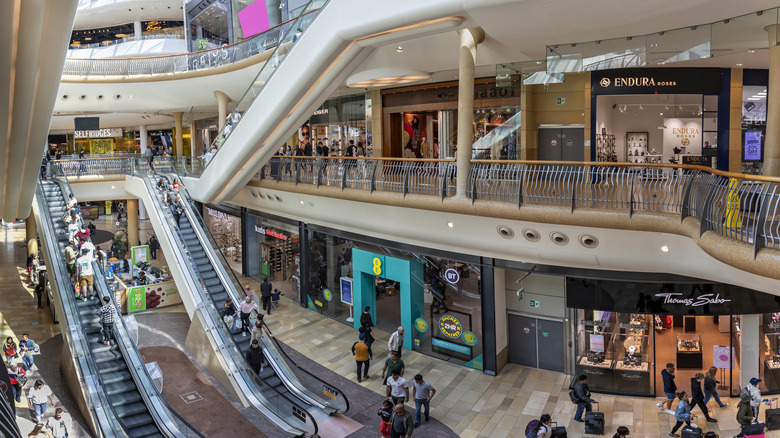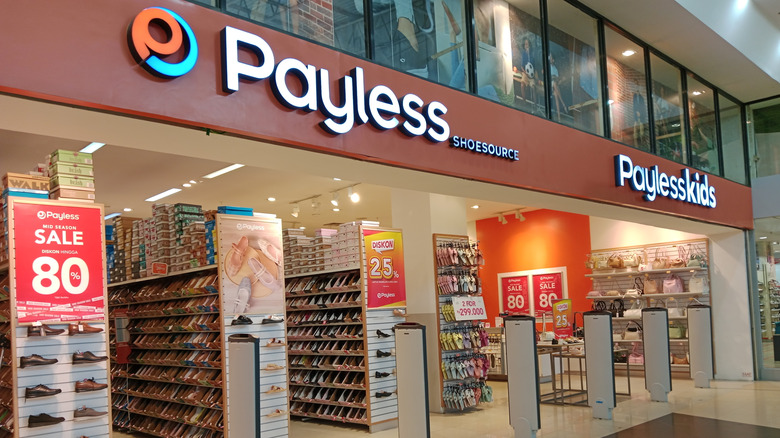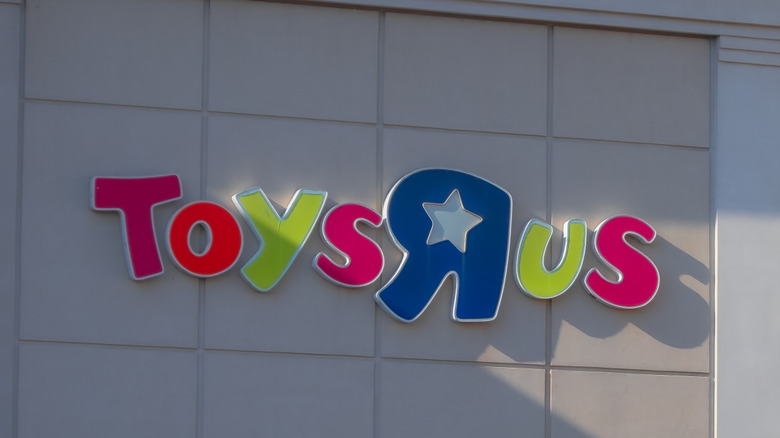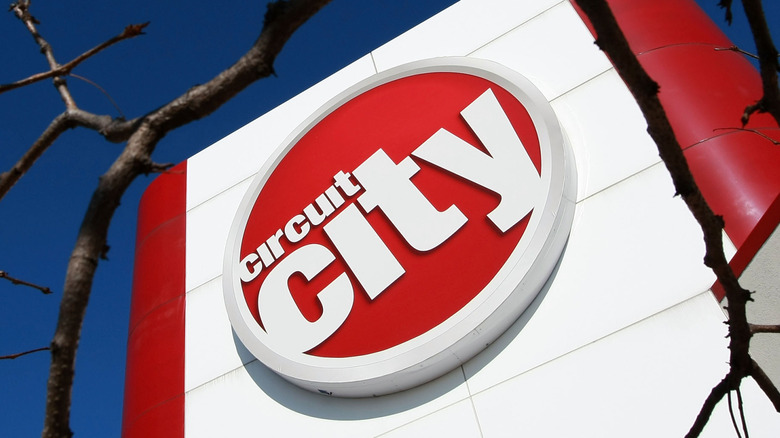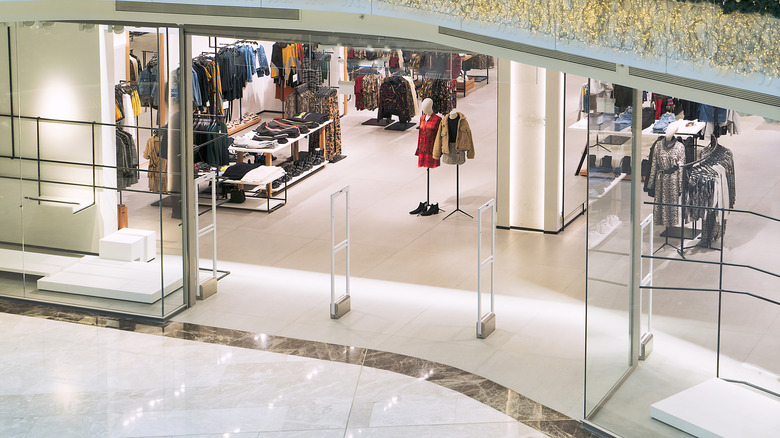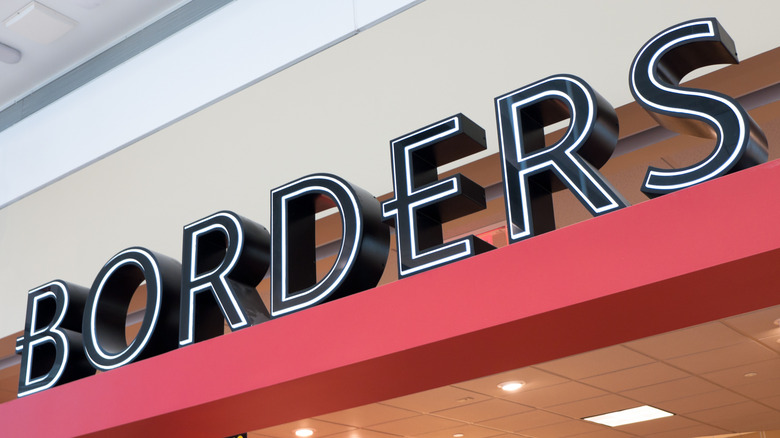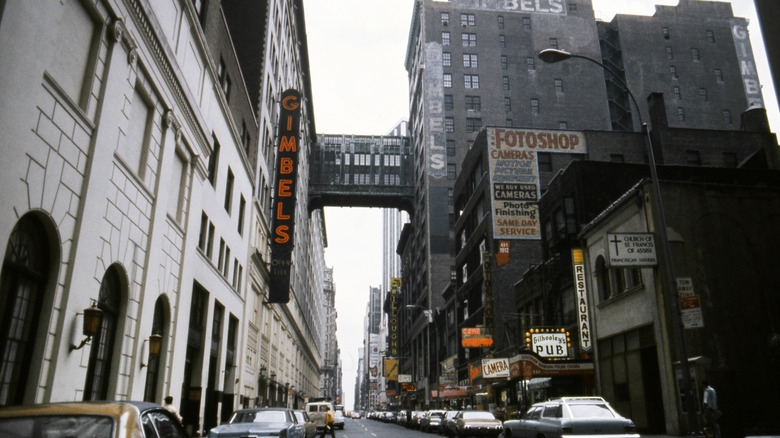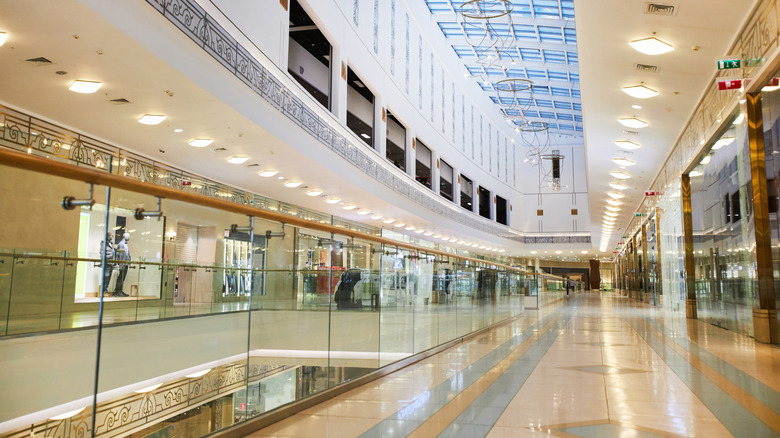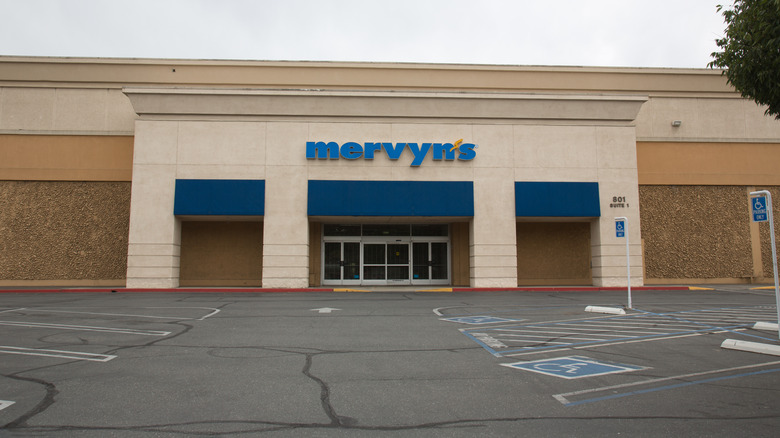Iconic Shopping Mall Retailers That Vanished
The United States has been referred to as the land of shopping malls, owing to the country's high density of these popular retail outlets. While the idea of putting several stores in a single location seems intuitive now, the shopping mall was a relatively novel idea back in the 1950s. Architect Victor Gruen, the grandfather of modern American malls, sought to recreate the busy town centers from his native Europe in his newfound home. Within a few decades, malls of various sizes and layouts began spreading quickly, and Capital One reports the U.S. was home to over 25,000 malls by 1986.
The exploding popularity of malls, their colossal footprints, and impressive revenue led many people to believe the pinnacle of shopping convenience had been achieved. At the turn of the century, though, people started visiting these hubs of commerce less frequently, with the same Capital One report informing that an average of 1,170 shopping malls closed in the U.S. annually from 2017 to 2022. Some of the most prominent and popular brands created in the rise of the American shopping mall were shuttered in these sweeping closures. Now, it feels as if once-iconic shopping mall retailers have largely vanished, and in some cases, that's exactly what happened.
Sears
Sears launched onto the retail scene in the late 1800s as a watch seller, focusing heavily on serving rural communities through its massive catalogue. What may appear to be an antiquated marketing strategy today was revolutionary at the time. After receiving investment infusions from a Chicago businessman, the Sears brand broadened its offerings beyond watches and expanded its service areas. It wasn't until 1925 that the catalogue-focused retailer opened its first retail store. By the 1950s, Sears became a cornerstone of the quintessential American shopping mall, with over 700 locations across the country, per the Smithsonian. The iconic mall brand was able to capitalize on its frontrunner status in the retail space for a few more decades before fundamental problems arose.
The rise of budget-friendly stores such as Walmart and Target undercut much of Sears' target demographic. The stagflation that characterized much of the 1970s economy drove consumers to seek more affordable alternatives. By 1991, the famous retailer was overtaken by Walmart as the country's largest retail brand. Sears attempted to shore up its dwindling finances through non-retail ventures. Sadly, the last-ditch attempts to save the retailer would prove futile as stores started falling like dominoes throughout the 2000s. As of 2025, only a handful of physical Sears locations remain in the country, and even the future of those is in question.
Payless
Payless is another well-known mall retailer that seemed to disappear overnight. Founded in 1956 by two cousins in Topeka, Kansas, the company focused on selling shoes to customers at discount rates. The unique selling point generated a lot of interest from the beginning, allowing the brand to expand its stores across the rest of the country. Between the early 1960s and the early 2000s, Payless grew from 50 locations in a handful of states to over 5,000 in several countries, Business Insider reports. The financial success even saw the brand launch onto the stock market as a publicly traded company.
Many of Payless' achievements can be connected to the retailer's positioning in malls, providing a steady stream of potential customers. Unfortunately, this initial tailwind would become a major obstacle to the shoe retailer's continued success. The advent of the internet meant Payless had to compete with the convenience of virtual shoe stores, such as Zappos, which could offer better deals due to lower operating costs. Facing financial ruin, the company was forced to file for bankruptcy in 2017 and again in 2019, closing thousands of its stores. Sadly, Payless isn't the only popular shoe retailer closing stores across the country.
Delia's
Delia's was a popular fashion brand throughout the early 2000s, serving girls and young women through personalized accessories and clothing. Similar to Sears, Delia's took a hybrid approach by building a massive catalogue outreach in addition to a network of stores. At its height, the lifestyle company had 55 million people receiving its magazine and 95 stores across the country. Speaking with Fast Company, a former Delia's employee attributed the chain's success to its ability to speak to a unique, underserved demographic at "the very start of the girl power movement." Sadly, like many companies on this list, the fashion icon struggled to keep up with the rapid evolution of the virtual shopping landscape.
In 2014, Delia's filed for Chapter 11 bankruptcy as it faced an unsustainable fiscal structure. At the time, the company faced a staggering $32.2 million in liabilities and dwindling sales. Many in the company's C-suite leadership stepped down simultaneously, effectively resigning to the brand's fate. According to the American Bankruptcy Institute, Delia's shares were trading at only 1.8 cents on the stock market, reflecting the downfall of the entire business. Locations in malls across the country staged closing sales to liquidate their inventory. Sadly, trends like this have only continued in the years since Delia's shut down: In fact, many popular fashion brands filed for bankruptcy in 2025.
Gadzooks
Gadzooks took off in Carrollton, Texas, in 1984 as a novel clothing brand. Selling retro-inspired looks reminiscent of the hippie movement with a contemporary tint, the mall-centric brand did well for a few decades as it opened more and more locations throughout various states. At its height, the clothing company had roughly 400 stores. The company experienced a shaky few years in the early 2000s, but attempts to rebrand as exclusively a young women's clothing store only went so far to reverse its fortunes.
Following years of lacking sales and fiscal problems, Gadzooks declared bankruptcy in 2004. According to The New York Times, the wave of store closures throughout the country put around 1,500 jobs in jeopardy — a testament to the brand's widespread popularity during its heyday. At the time, the company faced a mountain of debt of $42.5 million and only around $85 million in assets. Eventually, the company was purchased by Forever 21, and all Gadzooks locations soon ceased to exist.
Toys R Us
Toys R Us was a juggernaut in the toy industry and one of the more accomplished retail brands, instantly recognizable in malls across the country and even the world. Yet, it couldn't escape the same trajectory as many of these legendary names. Upon returning from World War II, Charles Lazarus had the prescient idea of opening a toy store. After hearing countless fellow service members talk about starting families, Lazarus believed demand for baby items would likely surge in the next few years. So, he opened Children's Bargain Town in 1948 in the nation's capital, and gradually pivoted the store's inventory from childcare necessities to toys over several years. The first Toys R Us opened in 1957.
Instead of focusing on local, one-off items, Lazarus sold brand-name, instantly recognizable toys in quantities no single retailer had ever achieved before. According to History, at the top of its game, Toys R Us dominated 25% of the global toy industry, operated 1,450 physical locations, and stocked 18,000 unique toys. What could've possibly brought the toy giant to its knees? Well, speaking with the University of Pennsylvania's Wharton School of Business, retail expert Mark Cohen attributed the demise of Toys R Us to "serial mismanagement." As economic competitors pushed their way into the market and virtual alternatives arose, Toys R Us had to evolve to survive, let alone thrive. Those necessary changes simply never came. Eventually, Toys R Us filed for bankruptcy and has been relegated primarily to mini-store locations within Macy's.
Circuit City
Circuit City experienced an electrifying explosion in popularity before an internal glitch crashed the once-ubiquitous brand. Started in Richmond, Virginia, in 1949, the electronics company originally focused on televisions. The founder, Sam Wurtzel, sought to capitalize on the nascent technology, predicting its mass appeal. As the Federal Reserve Bank of Richmond reports, the forecast paid off with TV ownership growing by a factor of 20 over the next five years. Wards, as the company was known at the time, was on the frontlines to benefit from that widespread adoption. This kicked off a national expansion and a brand change to Circuit City. Over the next few decades, the chain opened hundreds of locations in malls throughout the country and spent much of the '90s and early 2000s in the Fortune 500.
However, its wave of success would eventually crash into the rising status of Best Buy, one of the companies that came roaring back from bankruptcy. In an attempt to minimize operating costs, Circuit City fired thousands of employees throughout the early 2000s, and proceeded to make some other radical business decisions — even buying the Canadian company InterTAN in 2004. Ultimately, Circuit City's financial standing suffered too greatly and, following a bankruptcy filing in 2008, the electronics company sold off over $1 billion worth of products and closed its stores for good.
Anchor Blue
Anchor Blue was a mall staple throughout the 1990s, offering a range of teen clothes and lifestyle products. Founded in California, the company got its start as Miller's Outpost, before becoming the popular purveyor of jeans and accessories that many came to know. For those unfamiliar, Anchor Blue can be thought of as a contemporary of Hollister or Aeropostale with a SoCal flair — though it was admittedly less successful than either of those examples. During its peak, Anchor Blue ran around 300 locations nationwide, with its largest footprint in the Western U.S.
Instead of standalone stores, the brand aimed to operate out of malls with plenty of foot traffic. This strategy worked for a few decades, until the company needed to file for bankruptcy in 2011. At the time, the store's total number of locations had already gone down by around 200 stores. Perry Ellis purchased Anchor Blue's intellectual property in the wake of its bankruptcy for $500,000. Anchor Blue executives attributed its downfall to the routinely low prices of bigger competitors, and the struggling economy of the era at large. A massive liquidation sale was ultimately staged to help offset some of the failing brand's debts before its doors finally closed. Bankruptcy can work in your favor, but that just wasn't the case for Anchor Blue.
Borders
Borders was the cornerstone bookstore of malls throughout the U.S. in the 1990s and well into the 2000s. The popular brand mastered the bookshop-cafe hybrid concept, encouraging everyone from college students and young families to visit, shop, and enjoy the atmosphere. Borders achieved maximal success in the mid-2000s when its profits eclipsed $100 million annually and maintained about 36,000 employees globally.
Amazon has some sneaky ways to trick customers into spending more, and the virtual shopping behemoth ultimately managed to slyly take out Borders. In 2001, Jeff Bezos' creation was in its infancy, focusing primarily on selling books online. Recognizing the importance of a digital presence, Borders began selling through the online retailer. Unfortunately, many view this decision as an impediment to the bookstore evolving digitally on its own merits. In the late 2000s, Borders underwent a series of changes to avoid financial ruin, including shuffling CEOs, closing hundreds of locations, cutting 1,500 jobs, and accepting loans from large funders. The attempt proved useless, and the company ultimately filed for bankruptcy in 2011.
Forever 21
In many ways, Forever 21's origin story embodies the classic American dream. Founded by two South Korean immigrants in the 1980s, it became one of the most recognizable and popular fashion brands in U.S. malls. The company got its start in Los Angeles as Fashion 21, focusing on offering trendy clothing at reasonable prices. After gaining a solid foothold in California, the clothing store began spreading to other domestic and international locations. However, the wide expansion would eventually overextend the brick-and-mortar fashion brand in the digital age. Suffering a similar fate to other mall-oriented stores in the 21st century, Forever 21 struggled to keep up with the discount offers made available by other online retailers.
Forever 21 initially claimed bankruptcy protection in 2019, and took on a variety of investors to bolster its financial padding. Among these late-stage investors were shopping mall giants, such as Brookfield Property Partners and Simon Property Group, highlighting the company's deep ties with the mall concept. The confluence of broad economic hurdles and internal problems forced Forever 21 to file for bankruptcy again in 2025. The chain held clearance sales while closing down operations across its network of locations.
Lazarus
In 1851, Simon Lazarus launched a small men's fashion store. Lazarus is often cited as a trailblazer in the mall retail space, setting many benchmarks that have become norms. For example, it normalized the now-standard fixed pricing scheme within stores. Furthermore, Lazarus helped kickstart the idea of a Bargain Basement, offering discounted prices in certain sections. Soon after its founding, the male-focused store expanded to offer women's clothing, considerably broadening its potential customer base. The move proved effective, and Lazarus accelerated its growth even more by joining forces with other leading retail brands from across the country to establish Federated Department Stores — which would eventually become Macy's.
The Lazarus family became so influential that the founder's grandson successfully petitioned Congress to place Thanksgiving on the fourth Thursday, instead of the last, to make for a longer seasonal shopping period. Unlike other iconic shopping mall retailers that appeared to vanish, Lazarus didn't face financial destruction. Instead, the company was squeezed out of use through various brand evolutions. In 2005, Federated Department Stores decided to absorb all Lazarus stores into the Macy's brand.
Gimbels
Gimbels was the brainchild of Jewish-German immigrant Adam Gimbel. Originally opened in the small town of Vincennes, Indiana, in 1842, the department store would become a household name in the U.S. According to American Business History, the company grew from employing 40 people in 1875 and owning a handful of local stores to leading the industry as one of most prosperous department brands in the 1920s. More than a mere store in malls, Gimbels was a cultural fixture throughout the 1900s. It was featured heavily in the successful Christmas film "Miracle on 34th Street," and even competed with the widely popular Macy's Thanksgiving Day Parade by throwing its own in Philadelphia. Eventually, Gimbels and Macy's entered a hard-fought rivalry over territory and customers.
Each brand worked to lower its prices — sometimes by the hour — to beat out the other. Sadly, despite surviving the Great Depression and experiencing a post-World War II boom, Gimbels struggled to stay relevant by the end of the 20th century in terms of profitability and trends. The group's Saks Fifth Avenue brand began to comprise an outsized proportion of its gains, taking much of the leadership's attention. The British-American Tobacco company bought Gimbels in 1973, but closed all locations by the late 1980s. It was the end of an era for the department store industry, and a sign of things to come: Even Macy's, now the largest retail store in the U.S., is closing more stores, underscoring mall giants' ongoing struggles.
L.S. Ayres
The L.S. Ayres brand achieved many firsts in its pursuit of retail chain prosperity, and introduced the Indianapolis area to the perks of modern mall convenience and affordability. The department store was an early adopter of various technological advancements, including elevators, incandescent lightbulbs, telephones, gas, and glass-encased displays. The company's founder shared information with nine other sizable chains, preferring a collaborative business relationship. However, the brand's rapid growth ended up making it undeniably competitive.
At its zenith, L.S. Ayres operated a web of branches throughout various states in the Midwest region, but industry-wide changes throughout the 20th century proved too much for the aging company to overcome. The L.S. Ayres brand was bought by Associated Dry Goods in 1972, forcing the closure of many stores. This seemingly unstoppable brand experienced the same fate as many iconic shopping mall retailers, eventually getting completely absorbed by Macy's. Today, no L.S. Ayres locations remain in operation, and the name has effectively been wiped from the collective mall memory.
Mervyn's
Mervin Morris opened a department store under his name in 1949 in San Lorenzo, California, which would become one of the most prominent mall brands in the country. Mervin grew the company step by step, starting with a pack of socks before introducing more clothes and eventually expanding into home, beauty, and lifestyle goods. Mervyn's honed in on the middle-class American, keeping its prices reasonable and its stores moderately sized. Mervyn's profitability helped launch it publicly in 1971, and the brand eventually grew to operate over 200 stores with a heavy focus in the Southern and Western U.S. Seven years later, Dayton Hudson, the precursor to Target, purchased Mervyn's. Unfortunately, the acquisition ultimately proved fatal for Mervyn's.
In 2008, Mervyn's filed for bankruptcy. The brand placed its inventory at a considerable discount to liquidate its assets across its remaining locations to help alleviate some of its burdens. In the end, the dwindling retail market proved too burdensome for the California-based retailer. Now, Mervyn's only sells online with a dramatically reduced number of products.
